
views
Performing a Pike Push-Up Correctly
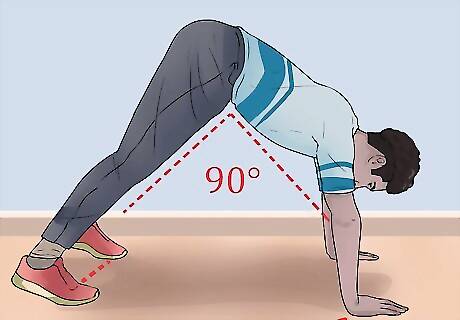
Warm up, then get into the correct position and form. Compared to a traditional push-up, a pike push-up uses a very different form. It's essential to make sure you get into the correct form to prevent injury. To start a pike push-up, get down into a regular or traditional push-up position. Your feet should be hip width apart and your arms should be shoulder width apart. Start to walk your hands backwards towards your feet. Keep your legs straight as you do this. Stop when your body forms an upside down "V" shape and between your torso and legs is a 90 degree angle. This will be your starting and ending position.
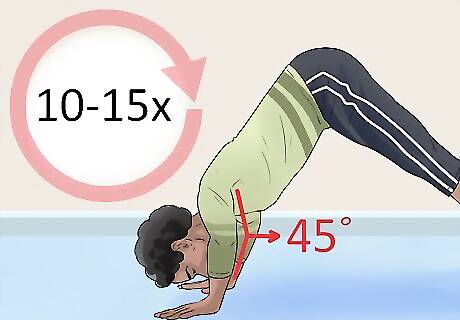
Bend your elbows to move your head towards the floor. Your elbows should be at a 45 degree angle to your body, meaning they shouldn't be straight out to the sides or pinned against the side of your body. Touch the ground with your head, then slowly push yourself back up to the starting position. This is one pike push-up. Start with as many pike push-ups as you can. Eventually aim for a set of 10-15 reps. As you improve, you can increase the amount of sets you do each time you exercise. Since the shoulders can be a delicate area of muscles, it's important to avoid overdoing it as you can injury yourself.
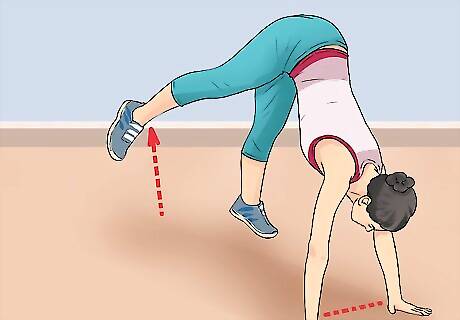
Increase the intensity of a pike push-up. Compared to a traditional push-up, the pike push-up may feel like a higher intensity exercise, especially if you have more upper body mass than lower body mass. However, if you find that you can easily do a pike push-up with little difficulty, there are ways to even increase the intensity and difficulty of this exercise. Begin in the starting position where your body is in an upside down "V" shape. Your hands should be shoulder width apart and your legs should be hip width apart. Before lowering your head towards the ground, lift your right leg into the air. It should track in a straight line (or close to it) with your back. With your leg raised, begin your pike push-ups. Bend your elbows out away from your body at a 45 degree angle until your head touches the ground. Slowly push yourself back up to the starting position. Repeat the push-up with your right leg raised 10 times. Then, switch and repeat your pike push-ups with your left leg raised in the air.
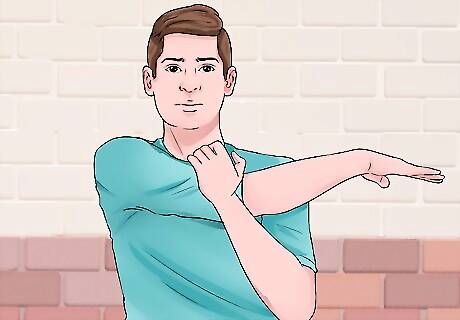
Stretch it out. Similar to range of motion exercises prior to a workout, it's equally important to stretch out your muscles after a work out. Some studies show this might relieve post workout soreness and help maintain range of motion and flexibility. Try some of these shoulder stretches after your push-up or shoulder exercises: Shoulder blade squeezes. While standing straight, squeeze your shoulder blades together until you feel a light stretch on the front of your shoulders. Hold for 20-30 seconds. Shoulder abduction stretches. Lift your arms straight out to the sides and continue until your fingers are pointing towards the ceiling. You should feel the sides of your shoulders being stretched. Cross body stretch. Bend one arm across your body at chest level. Press your arm into your chest with your free arm until you feel a light stretch in your shoulder. Switch sides. You can also do this across your back, holding the back arm in place with your other hand.
Increasing Strength and Muscle Mass of Your Shoulders
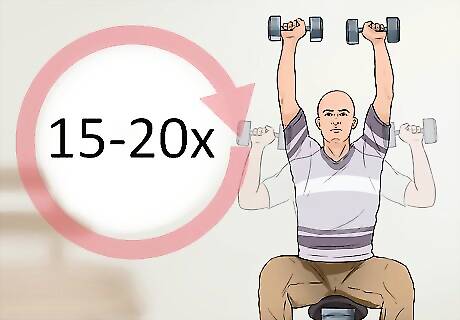
Include barbell or dumbbell shoulder presses. A classic shoulder exercise that will complement pike push-ups well are shoulder presses. They really help build strength and mass in the shoulders. While sitting on the end of a bench, hold a dumbbell in each hand. Keep your back straight and head facing forward. Lift your arms up so your upper arm is parallel to the floor and your palms are facing forward. The dumbbells should be resting near your ears. Slowly push the dumbbells up and fully extend your arms or until they are straight. Slowly lower your arms back down to shoulder level. Repeat this exercise 6-8 times if you are using very heavy weights, 8-12 times with moderately heavy weights, or 12-15 times with lighter weights. Heavier weights will build muscle while lighter weights will improve endurance.
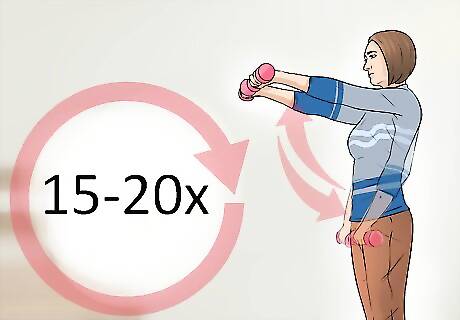
Do front raises. Front raises are a really great exercise that works the entire shoulder muscle. They're fairly easy to do and only require a small set of dumbbells to perform. Hold a dumbbell in each hand while standing straight up. Your feet should be hip width apart to help you balance appropriately. While keeping your torso straight and abs contracted, slowly lift up your arms while keeping your palms facing the ground. Lift your arms up until they become perpendicular to the floor. Hold the dumbbells at this elevated position for a few seconds. Slowly lower your arms back down to your sides. Repeat 6-8 times with heavy weights, 8-12 times with moderately heavy weights, or 12-15 times with lighter weights.
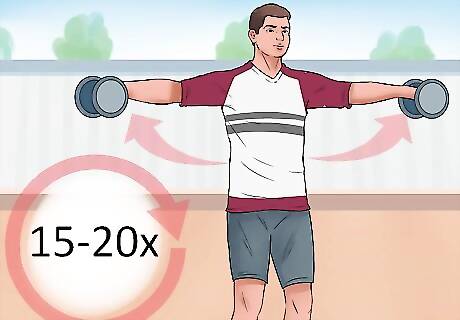
Add in deltoid side raises. The deltoid is a combination of 3 muscles around your shoulder. These deltoid raises work the front, middle and back of your shoulder muscles. While standing straight up, hold two dumbbells in each hand. Your feet should be hip width apart to help you balance appropriately. Bend your arms at your elbow so they are bent at a 90 degree angle. Lift your arms up until your upper arms are parallel with the floor. Make sure to lead with your elbow as you bring your arms up. Hold this elevated position for a few seconds. Slowly release your arms back down to the sides of your body. Do 6-8 reps if you are using very heavy weights, 8-12 reps if you are using moderate weights, or 12-15 reps if you are using light weights.
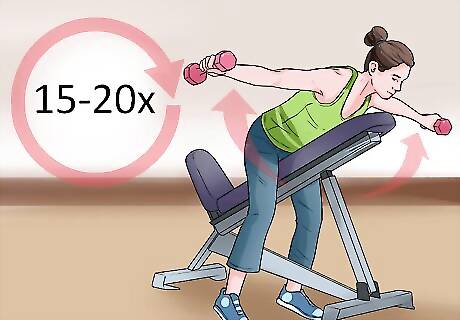
Include reverse flyes. Reverse flyes are a great exercise to include with pike push-ups. They work the top and back of the shoulder as well as the upper back. Grab two dumbbells and lay face down on an incline bench. Your face should be pointed towards the floor. Hold one dumbbell in each hand. Raise your arms out in front of you so they are perpendicular to the bench. Your palms should be facing towards each other. Slowly move your hands backwards so they make a "T" shape with your body. Hold this position while squeezing your shoulder blades together. Slowly release your arms back so they are in front of you again. Repeat these flyes 6-8 times with very heavy weights, 8-12 times with moderately heavy weights, or 12-15 times with lighter weights.
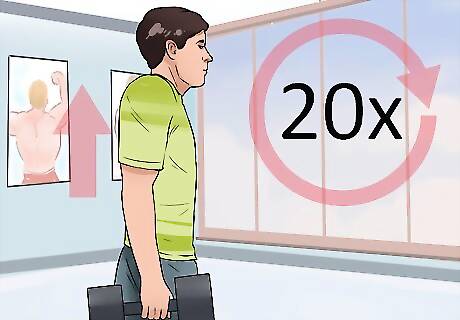
Do shoulder shrugs. If you're specifically looking for exercises that will help build more muscle mass around your shoulders, consider including shoulder shrugs along with your pike push-ups. To start, hold a weighted barbell with both hands. Your hands should be about shoulder width apart. Pull up the weighted bar with your shoulders - do not use your arms for help. Your shoulders should end up near your ears. Hold the bar in this position for a few seconds before relaxing back down. Heavy weights will build muscle; do 6-8 reps per set if you're using very heavy weights and 8-12 reps per set if you're using moderately heavy. To build endurance only, use lighter weights; aim for 12-15 reps per set. Rest in between each set.
Incorporating Pike Push-Ups Into Your Exercise Routine
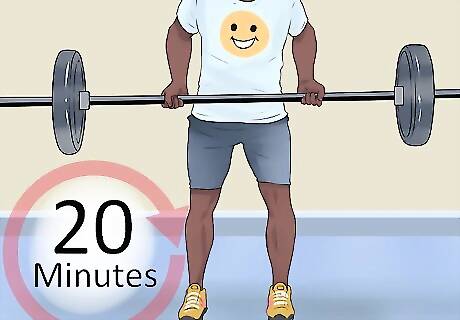
Do other forms of strength training. Outside of pike push-ups and other shoulder exercises, it's important to ensure you're working other parts of your body and major muscle groups. Add in additional strength training for a well balanced exercise routine. Strength training not only builds and tones lean muscle mass, but can help prevent osteoporosis (and subsequent fractures or breaks) and even increase your metabolism. Whenever you're doing any type of strength training, aim to be working out for at least 20 minutes total. During each workout or during the week you should work every major muscle group including your shoulders. Include at least 1 or 2 days of strength training each week. However, you can do strength training daily if you alternate muscles groups each day. You can do a combination of body weight exercises (like pike push-ups) in addition to using weight machines, free weights or doing classes like yoga or pilates.
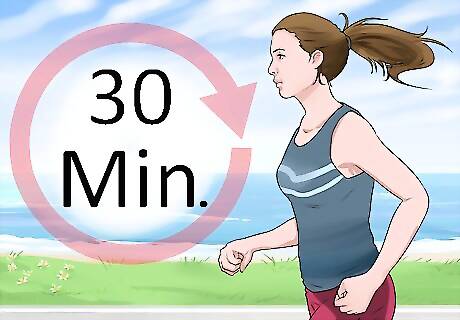
Add in adequate amounts of cardio. Although strength training has many benefits, it's important to include adequate amounts of cardio or aerobic exercises each week. Health professionals typically recommend you aim for 150 minutes of aerobic exercises each day. This ends up being about 2 1/2 hours or 30 minutes of exercise 5 days a week. Aerobic exercise comes with different benefits compared to strength training. It helps burn calories and support a healthy weight, reduces your risk of strokes and developing diabetes, decreases your risk for sleep apnea and high blood pressure. Although you may feel slightly out of breath or sweaty when you perform strength training activities, these do not count as cardio. You need to do exercises like walking, jogging, swimming, using the elliptical machine or rowing machine.

Give your shoulders a break. Including an adequate amount of rest days is probably equally important to using the correct form, stretching and including a warm-up before you exercise. Make sure to plan in a few rest days each week. Most health and fitness professionals will recommend that you include a minimum of 1-2 rest days each week. This is even more important if you lift weights often or are a body builder. It's during rest and recovery that your muscles actually grow in size, gain more mass and increase in strength. It's not during weight lifting that this happens. In addition, the shoulder area has a lot of muscles, ligaments and tendons that can easily be overworked. It's important to give them adequate rest so you do not increase your risk of an injury.

Be mindful of aches and pains in your shoulders. A little soreness after a tough workout can be a good thing - you worked hard. However, aches, pains or soreness that doesn't go away could signal an injury and should be addressed immediately. Unfortunately, the shoulder is an easy area to injure. The large amount of small muscles, tendons and ligaments in this joint are more prone to injury than other muscles (like your quadriceps). If you notice any of the following symptoms, you may have injured yourself: constant dull pain, sharp acute pain, pain that gets worse during the day, pain that makes it difficult to sleep at night, pain that limits your range of motion, shoulder stiffness, arm numbness or tingling, an inability to move your shoulder or redness and swelling. If you notice any of these symptoms you should discontinue all shoulder and arm exercises and see a doctor immediately for further evaluation. Continuing to exercise can exacerbate an injury and make it worse.














Comments
0 comment